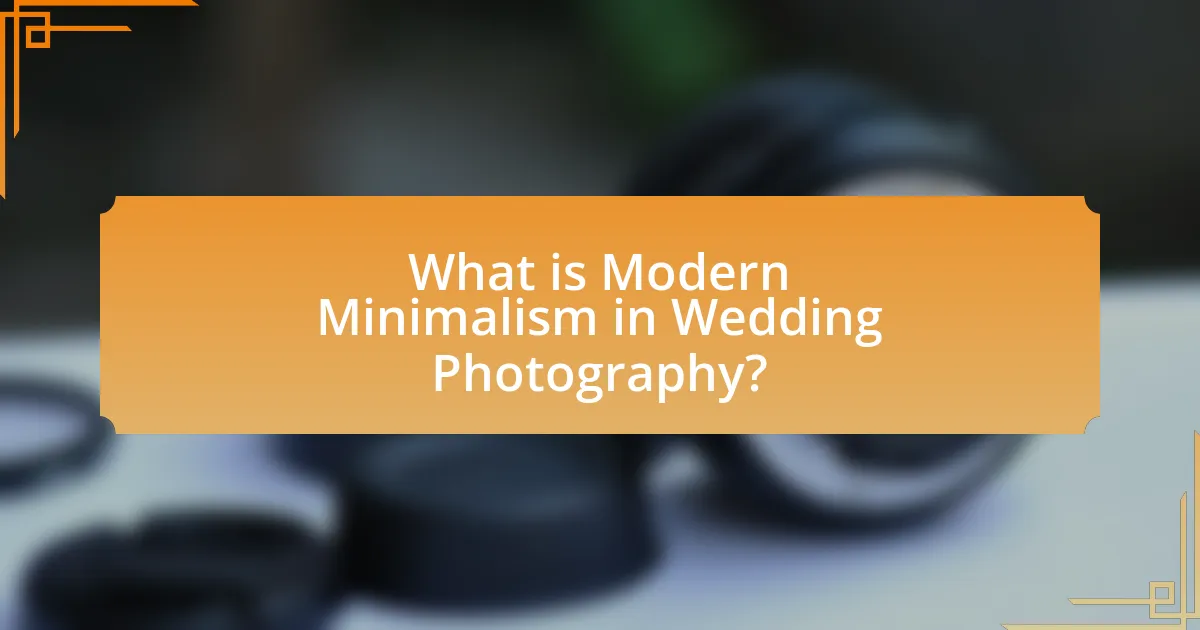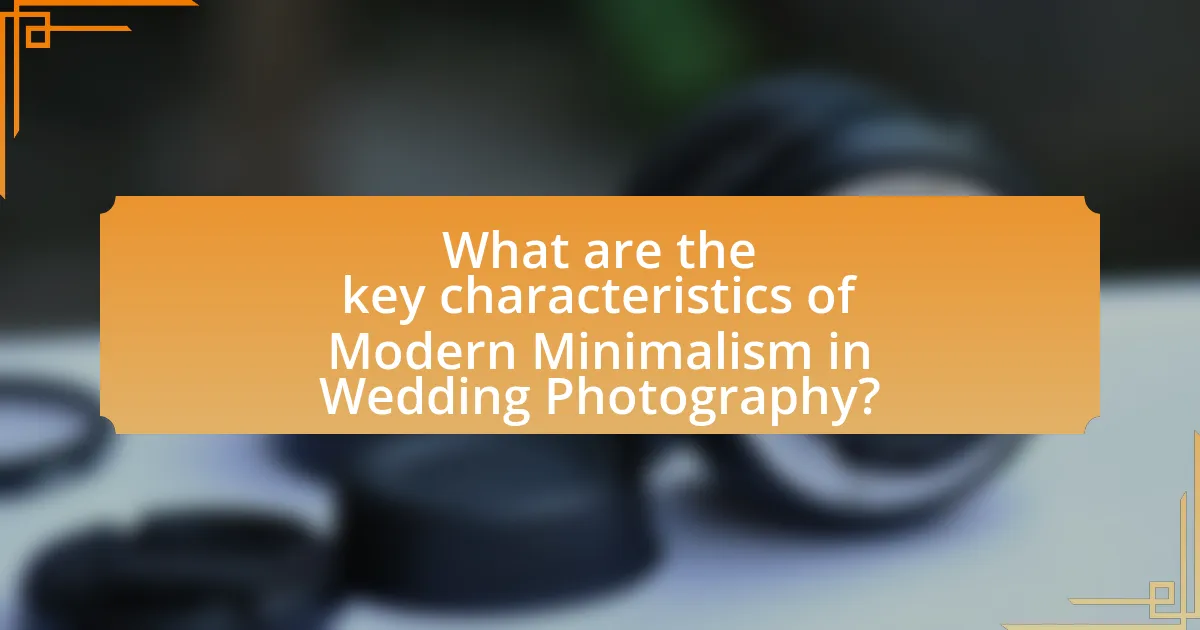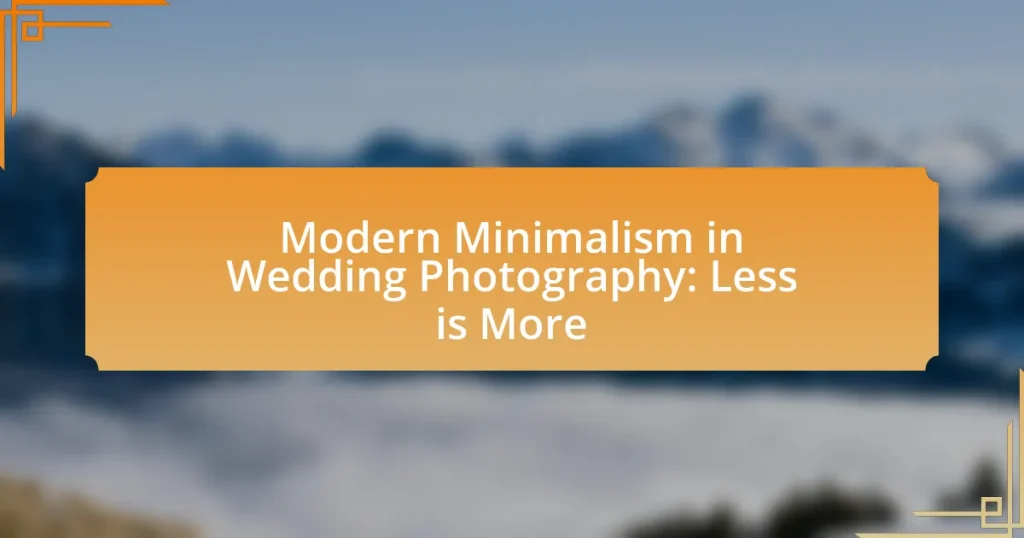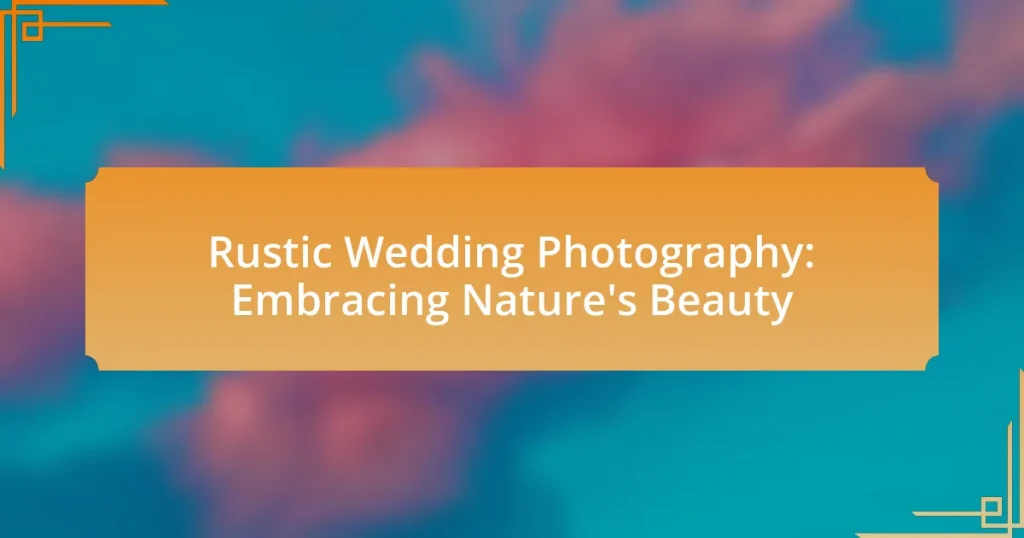Modern Minimalism in Wedding Photography is a style that prioritizes simplicity and clean aesthetics, focusing on essential elements while minimizing distractions. This article explores the emergence of this approach, its key principles, and how it contrasts with traditional wedding photography styles. It highlights the significance of the “Less is More” philosophy, the role of lighting and composition, and practical tips for photographers looking to adopt this minimalist aesthetic. Additionally, it addresses common misconceptions and challenges faced by photographers in this genre, providing insights into effective techniques and equipment suited for minimalist wedding photography.

What is Modern Minimalism in Wedding Photography?
Modern Minimalism in Wedding Photography is a style that emphasizes simplicity and clean aesthetics, focusing on essential elements while eliminating distractions. This approach often features uncluttered compositions, natural lighting, and a limited color palette, allowing the emotions and connections between the couple and their surroundings to take center stage. The effectiveness of this style is supported by its ability to create timeless images that resonate with viewers, as seen in the works of renowned photographers who adopt minimalistic techniques to capture the essence of weddings without overwhelming details.
How did Modern Minimalism emerge in Wedding Photography?
Modern Minimalism emerged in wedding photography as a response to the overly ornate and cluttered styles prevalent in earlier decades. This shift began in the early 2000s, influenced by broader design trends that emphasized simplicity, clean lines, and a focus on essential elements. Photographers started to prioritize natural light, negative space, and candid moments, moving away from posed and heavily edited images. The rise of social media platforms, particularly Instagram, further propelled this trend, as couples sought to showcase authentic and visually striking images that resonated with minimalist aesthetics.
What are the key principles of Modern Minimalism in this context?
The key principles of Modern Minimalism in wedding photography include simplicity, focus on essential elements, and the use of negative space. Simplicity emphasizes capturing moments without excessive props or distractions, allowing the couple’s emotions and interactions to take center stage. Focusing on essential elements means highlighting significant details, such as rings or intimate gestures, rather than overwhelming the viewer with clutter. The use of negative space enhances the composition, drawing attention to the subjects and creating a sense of calm and clarity in the images. These principles collectively aim to convey the beauty of the moment through a clean and understated aesthetic, aligning with the “less is more” philosophy.
How does Modern Minimalism differ from traditional wedding photography styles?
Modern Minimalism in wedding photography emphasizes simplicity and clean aesthetics, contrasting sharply with traditional styles that often focus on elaborate compositions and posed shots. While traditional wedding photography typically captures a wide range of moments, including staged family portraits and detailed decor, modern minimalism prioritizes candid, unembellished images that highlight genuine emotions and interactions. This approach often utilizes negative space and a limited color palette, allowing the couple and their connection to take center stage, whereas traditional styles may overwhelm the viewer with intricate backgrounds and multiple subjects. The shift towards minimalism reflects a broader cultural trend valuing authenticity and emotional resonance over ornate presentation.
Why is the concept of ‘Less is More’ significant in Wedding Photography?
The concept of ‘Less is More’ is significant in wedding photography because it emphasizes simplicity and clarity, allowing the emotional essence of the event to shine through without distraction. This approach focuses on capturing genuine moments and details that convey the couple’s story, rather than overwhelming the viewer with excessive elements. Studies have shown that minimalist photography can enhance viewer engagement by directing attention to key emotional expressions and interactions, making the images more impactful and memorable.
How does ‘Less is More’ influence the choice of subjects and compositions?
The principle of ‘Less is More’ significantly influences the choice of subjects and compositions in modern minimalism by emphasizing simplicity and clarity. This approach encourages photographers to select fewer elements in a frame, focusing on essential subjects that convey emotion and narrative without distraction. For instance, a single couple in a vast landscape can evoke a sense of intimacy and connection, highlighting their relationship against a minimalist backdrop. This method not only enhances visual impact but also allows viewers to engage more deeply with the subject matter, as seen in the works of renowned minimalist photographers like Hiroshi Sugimoto, who often utilize stark compositions to evoke profound feelings.
What emotional responses does ‘Less is More’ evoke in viewers?
The concept of “Less is More” in modern minimalism evokes feelings of tranquility, clarity, and intimacy in viewers. This aesthetic emphasizes simplicity, allowing viewers to focus on the emotional essence of the moment rather than being distracted by excessive details. Research indicates that minimalistic designs can reduce cognitive overload, leading to a more profound emotional connection with the subject matter. For instance, studies in visual perception show that simplicity can enhance emotional responses by fostering a sense of calm and appreciation for the beauty of understated elegance.

What are the key characteristics of Modern Minimalism in Wedding Photography?
Modern Minimalism in Wedding Photography is characterized by simplicity, clean lines, and a focus on essential elements. This style emphasizes the beauty of the moment without distractions, often utilizing negative space to draw attention to the couple and their emotions. Additionally, the color palette is typically muted, favoring soft tones and natural light to create an ethereal atmosphere. The composition often features uncluttered backgrounds and straightforward framing, allowing the subject to stand out. These characteristics reflect a broader trend in contemporary design that values authenticity and emotional connection over ornate details.
How does lighting play a role in Minimalist Wedding Photography?
Lighting is crucial in Minimalist Wedding Photography as it enhances simplicity and focuses attention on essential elements. The use of natural light or soft artificial lighting creates a clean aesthetic, allowing the couple and their surroundings to stand out without distractions. For instance, diffused sunlight can produce gentle shadows and highlights that emphasize textures and forms, aligning with the minimalist philosophy of “less is more.” This approach not only captures the emotional essence of the moment but also adheres to the minimalist principle of clarity and simplicity, making lighting a fundamental aspect of the overall composition.
What types of lighting techniques are commonly used?
Commonly used lighting techniques in wedding photography include natural light, flash, and continuous lighting. Natural light is favored for its soft and flattering qualities, often utilized during golden hour for optimal results. Flash techniques, such as off-camera flash, provide versatility and control in various lighting conditions, allowing photographers to create dramatic effects or fill in shadows. Continuous lighting, often used in studio settings, offers consistent illumination, making it easier to visualize the final image. These techniques are essential for achieving the desired aesthetic in modern minimalist wedding photography, where simplicity and clarity are prioritized.
How does natural light enhance minimalist compositions?
Natural light enhances minimalist compositions by creating a soft, diffused illumination that emphasizes simplicity and clarity. This type of lighting reduces harsh shadows and highlights, allowing the essential elements of the composition to stand out without distraction. For instance, in wedding photography, natural light can highlight the couple’s expressions and the surrounding environment, reinforcing the minimalist aesthetic by focusing on fewer, yet more impactful, visual elements. Studies in photography demonstrate that natural light can evoke emotions and create a sense of intimacy, which aligns perfectly with the principles of modern minimalism.
What types of compositions are favored in Modern Minimalism?
Modern Minimalism in wedding photography favors compositions that emphasize simplicity, negative space, and essential elements. This approach often includes clean lines, uncluttered backgrounds, and a focus on the subject, allowing the emotional connection and the moment to take precedence. For instance, compositions may feature a single couple against a vast landscape or a close-up of hands exchanging rings, highlighting intimacy without distractions. The effectiveness of these compositions is supported by the principle that less visual information can lead to a stronger emotional impact, as seen in the works of renowned minimalist photographers who prioritize clarity and focus in their imagery.
How do negative space and simplicity contribute to effective compositions?
Negative space and simplicity enhance effective compositions by directing focus and creating visual clarity. Negative space, the area surrounding the main subject, allows the viewer’s eye to rest and emphasizes the subject, making it stand out. Simplicity reduces distractions, enabling a more powerful emotional connection with the image. Research indicates that compositions with ample negative space and minimal elements are perceived as more aesthetically pleasing, as they align with the principles of modern minimalism, which advocates for “less is more.” This approach is particularly effective in wedding photography, where capturing the essence of the moment without clutter can evoke stronger emotional responses.
What are some examples of successful minimalist compositions in wedding photography?
Successful minimalist compositions in wedding photography often include isolated subjects against simple backgrounds, such as a bride in a plain white dress standing in a vast, empty field. Another example is a close-up shot of wedding rings placed on a single flower petal, emphasizing the details without distractions. Additionally, a couple framed within a doorway or archway, with minimal decor around them, highlights their connection while maintaining a clean aesthetic. These compositions effectively use negative space to draw attention to the subjects, creating impactful images that resonate with the principles of modern minimalism.

How can photographers effectively implement Modern Minimalism in their work?
Photographers can effectively implement Modern Minimalism in their work by focusing on simplicity, negative space, and essential elements. This approach emphasizes clean compositions that highlight the subject without distractions, allowing viewers to engage more deeply with the image. For instance, using a limited color palette and avoiding clutter in the frame can enhance the minimalist aesthetic. Research indicates that minimalist designs can lead to improved viewer engagement, as they reduce cognitive load and allow for clearer communication of the intended message. By prioritizing these principles, photographers can create impactful images that resonate with the essence of Modern Minimalism.
What techniques can photographers use to embrace Minimalism?
Photographers can embrace Minimalism by focusing on simplicity, negative space, and limited color palettes. By using simplicity, photographers eliminate distractions, allowing the subject to stand out. Negative space enhances the composition by emphasizing the subject against a clean background, which is a hallmark of Minimalist photography. Additionally, employing a limited color palette creates a cohesive and harmonious image, reinforcing the Minimalist aesthetic. These techniques are effective in wedding photography, where capturing the essence of the moment with clarity and focus is essential.
How can photographers select the right moments to capture?
Photographers can select the right moments to capture by focusing on genuine emotions and interactions during the event. This approach aligns with the principles of modern minimalism, which emphasizes simplicity and authenticity. By observing the dynamics between people, photographers can anticipate key moments such as laughter, tears, or intimate exchanges that convey the essence of the occasion. Research indicates that capturing candid moments rather than posed shots often results in more impactful and memorable images, as these moments reflect true emotions and connections.
What equipment is best suited for Minimalist Wedding Photography?
The best equipment for Minimalist Wedding Photography includes a lightweight mirrorless camera, a prime lens with a wide aperture, and a portable tripod. A mirrorless camera, such as the Sony A7 series, offers high image quality and compactness, making it ideal for capturing simple yet elegant moments. A prime lens, like a 50mm f/1.8, allows for beautiful depth of field and sharp images, which aligns with the minimalist aesthetic. Additionally, a portable tripod provides stability for low-light situations without adding bulk. This combination of equipment supports the minimalist approach by emphasizing simplicity and quality in photography.
What challenges might photographers face when adopting a Minimalist approach?
Photographers adopting a Minimalist approach may face challenges such as limited subject matter and the need for heightened creativity. The Minimalist style emphasizes simplicity, which can restrict the variety of scenes and elements that photographers typically capture, potentially leading to a lack of visual interest. Additionally, this approach requires photographers to think critically about composition and lighting, as every element in the frame must serve a purpose. Research indicates that successful Minimalist photography often relies on strong conceptual ideas, which can be difficult to develop consistently. Therefore, photographers must invest time in refining their vision and skills to effectively convey emotions and narratives within a simplified context.
How can photographers overcome common obstacles in Minimalist photography?
Photographers can overcome common obstacles in Minimalist photography by focusing on simplicity and intentional composition. By reducing distractions in the frame and emphasizing key elements, photographers can create impactful images that convey emotion and narrative. Techniques such as using negative space, selecting a limited color palette, and isolating subjects help to enhance the minimalist aesthetic. Research indicates that minimalist designs can lead to improved viewer engagement, as they allow the audience to focus on the essential aspects of the photograph, thereby reinforcing the message and emotional connection.
What misconceptions exist about Minimalism in Wedding Photography?
One misconception about minimalism in wedding photography is that it lacks creativity and emotional depth. In reality, minimalism emphasizes simplicity and intentionality, allowing photographers to focus on the essence of the moment rather than overwhelming details. This approach can lead to powerful storytelling through carefully composed images that highlight genuine emotions and connections. Studies have shown that minimalist designs can evoke stronger emotional responses, as they eliminate distractions and draw attention to the subject matter. Thus, minimalism in wedding photography can be both creative and deeply expressive, contrary to the belief that it is simplistic or uninspired.
What are some practical tips for aspiring Minimalist Wedding Photographers?
Aspiring Minimalist Wedding Photographers should focus on simplicity, intentionality, and storytelling in their work. To achieve this, they can start by selecting a limited color palette and using natural light to create soft, authentic images. Additionally, they should prioritize capturing genuine moments over posed shots, which aligns with the minimalist philosophy of focusing on what truly matters.
Investing in quality equipment that allows for versatility and ease of use is also crucial; for instance, a prime lens can help achieve a shallow depth of field, emphasizing subjects while blurring distractions. Furthermore, studying the work of established minimalist photographers can provide inspiration and insight into effective composition and framing techniques.
By practicing these strategies, aspiring photographers can develop a unique style that embodies the essence of minimalism, ultimately enhancing their portfolio and attracting clients who appreciate this aesthetic.


